 |
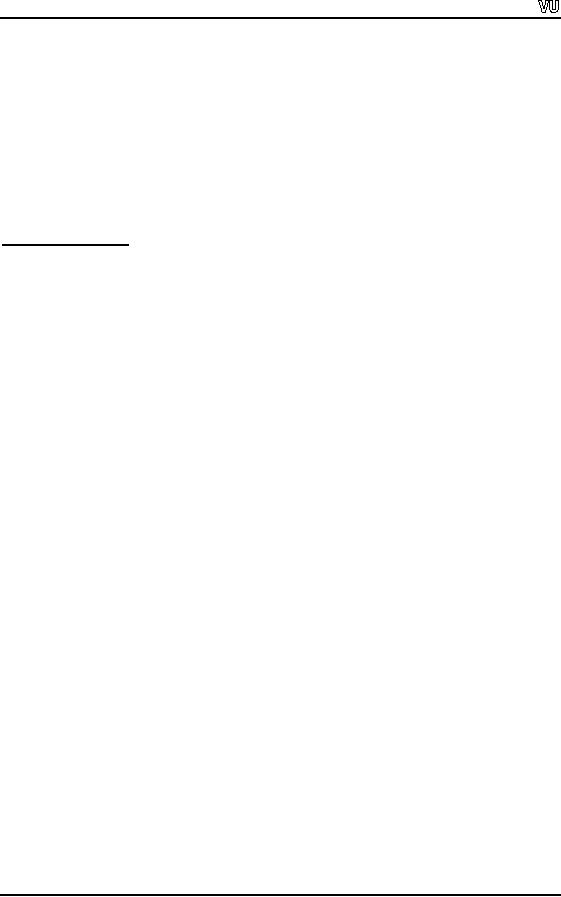
CS201
Introduction to Programming
Lecture
Handout
Introduction
to Programming
Lecture
No. 17
Reading
Material
Deitel
& Deitel - C++ How to
Program
Chapter
5
5.29,5.30,
5.31, 5.32, 5.33,
5.34
Chapter
16
16.16
16.33 ( Pages 869
884)
Summary
·
String
Handling
·
String
Manipulation Functions
·
Character
Handling Functions
·
Sample
Program
·
String
Conversion Functions
·
String
Functions
·
Search
Functions
·
Examples
·
Exercises
String
Handling
We have
briefly talked about 'Strings' in some of
the previous lectures. In
this lecture,
you
will see how a string may be
handled. Before actually discussing
the subject, it is
pertinent
to know how the things were going on
before the evolution of the
concept of
'strings'.
When C
language and UNIX operating
system were being developed in
BELL
Laboratories,
the scientists wanted to publish the
articles. They needed a text editor
to
publish
the articles. What they
needed was some easy mechanism by
which the articles
could be formatted
and published. We are
talking about the times
when PCs and
word
Page
194
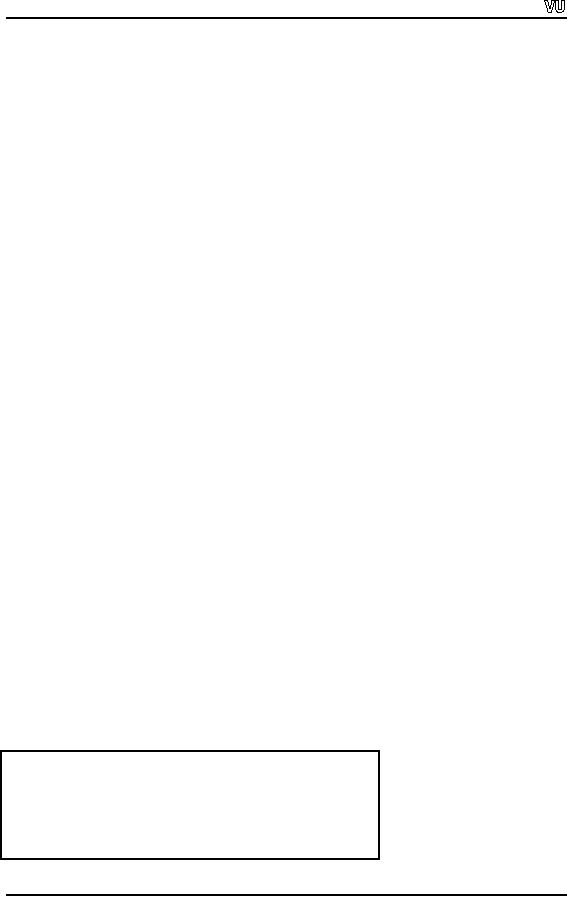
CS201
Introduction to Programming
processors
did not exist. It may be
very strange thing for
you people who can
perform
the
tasks like making the
characters bold, large or format a
paragraph with the help
of
word
processors these days. Those
scientists had not such a
facility available with them.
The
task of writing article and
turning into publishable material was
mainly done with
the
help of
typewriters. Then these computer
experts decided to develop a
program, which
could
help in the processing of
text editing in an easy
manner. The resultant efforts
led to
the
development of a program for editing
the text. The process to
edit text was called text
processing.
The in- line commands were
written as a part of the
text and were
processed
on out
put. Later, such programs
were evolved in which a command was inserted
for the
functions
like making the character
bold. The effect of this command could be
preview
and
then modified if
needed.
Now
coming to the topic of
strings again, we will
discuss in detail the in-built
functions
to handle
the strings.
String
Manipulation Functions
C
language provides many functions to manipulate
strings. To understand the
functions,
let's
consider building block (or
unit) of a string i.e., a character.
Characters are
represented
inside the computers in terms of
numbers. There is a code
number for each
character,
used by a computer. Mostly
the computers use ASCII
(American Standard
Code
for Information Interchange)
code for a character to
store it. This is used in
the
computer
memory for manipulation. It is
used as an output in the form of
character. We
can
write a program to see the
ASCII values.
We have a
data type char
to
store a character. A character includes
every thing, which we
can type
with a keyboard for example
white space, comma, full
stop and colon etc all
are
characters.
0, 1, 2 are also characters.
Though, as numbers, they are
treated differently,
yet they
are typed as characters.
Another data type is called as int, which
stores whole
numbers.
As we know that characters
are stored in side computer as
numbers so these can
be manipulated in
the same form. A character
is stored in the memory in
one byte i.e. 8
bits. It
means that 28 (256)
different combinations for different
values can be stored.
We
want to
ascertain what number it
stores, when we press a key
on the board. In
other
words, we
will see what character
will be displayed when we
have a number in
memory.
The
code of the program, which
displays the characters and their
corresponding integer,
values
(ASCII codes) as
under.
In the
program the statement c = i
;
has integer value on right
hand side (as i is an
int)
while
c
has
its character representation. We
display the value of i
and
c. It shows us
the
characters
and their integer
values.
//This
program displays the ASCII
code table
# include
<iostream.h>
main (
)
{
Page
195
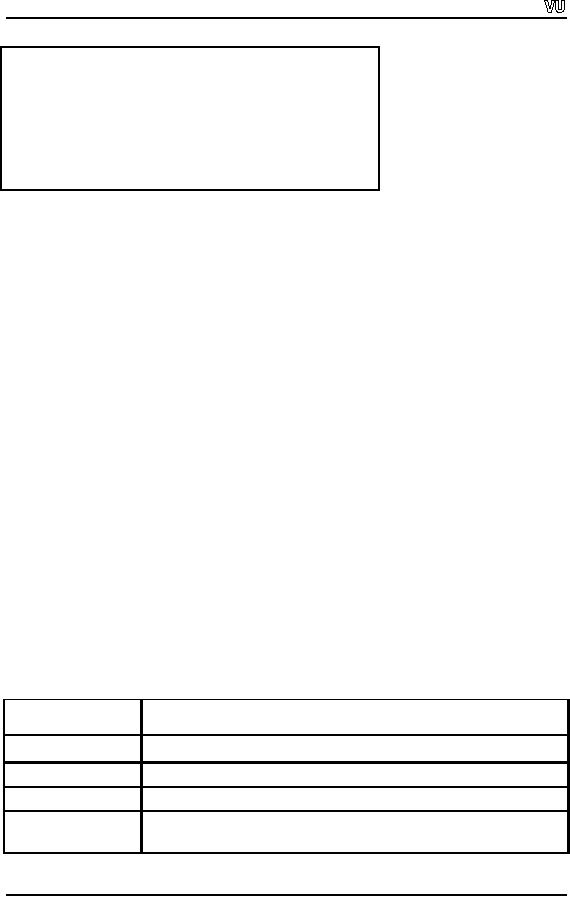
CS201
Introduction to Programming
int i,
char c ;
for (i =
0 ; i < 256 ; i ++)
{
c=i;
cout
<< i << "\t" << c << "\n"
;
}
}
In the
output of this program, we will
see integer numbers and
their character
representation.
For example, there is a character,
say white space (which we
use between
two
words). It is a non-printable character
and leaves a space. From
the ASCII table, we
can
see that the values of a-z
and A-Z are continuos. We
can get the value of an
alphabet
letter by
adding 1 to the value of its
previous letter. So what we need to
remember as a
baseline
is the value of `a' and
`A'.
Character
Handling Functions
C
language provides many functions to
perform useful tests and manipulations
of
character
data. These functions are found in
the header file ctype.h. The
programs that
have
character manipulation or tests on
character data must have included
this header file
to avoid
a compiler error. Each
function in ctype.h
receives
a character (an int ) or
EOF
(end of
file; it is a special character) as an
argument. ctype.h
has many
functions, which
have
self-explanatory names.
Of these,
int
isdigit (int c) takes a
simple character as its
argument and returns true
or
false.
This function is like a
question being asked. The
question can be described
whether
it is a
character digit? The answer
may be true or false. If the
argument is a numeric
character
(digit), then this function
will return true otherwise
false. This is a useful
function
to test the input. To check
for an alphabet (i.e. a-z), the
function isalpha
can
be
used.
isalpha
will
return true for alphabet a-z
for small and capital
letters. Other than
alphabets,
it will return false. The
function isalnum
(is
alphanumeric) returns true if
its
argument
is a digit or letter. It will return
false otherwise. All the functions included
in
ctype.h
are
shown in the following table
with their description.
Prototype
Description
Returns
true
if
c
is a
digit and false
otherwise.
int
isdigit( int c )
int
isalpha( int c )
Returns
true
if
c
is a
letter and false
otherwise.
int
isalnum( int c ) Returns
true
if
c
is a
digit or a letter and false
otherwise.
Returns
true
if
c
is a
hexadecimal digit character and
false
int
isxdigit( int c )
otherwise.
Page
196
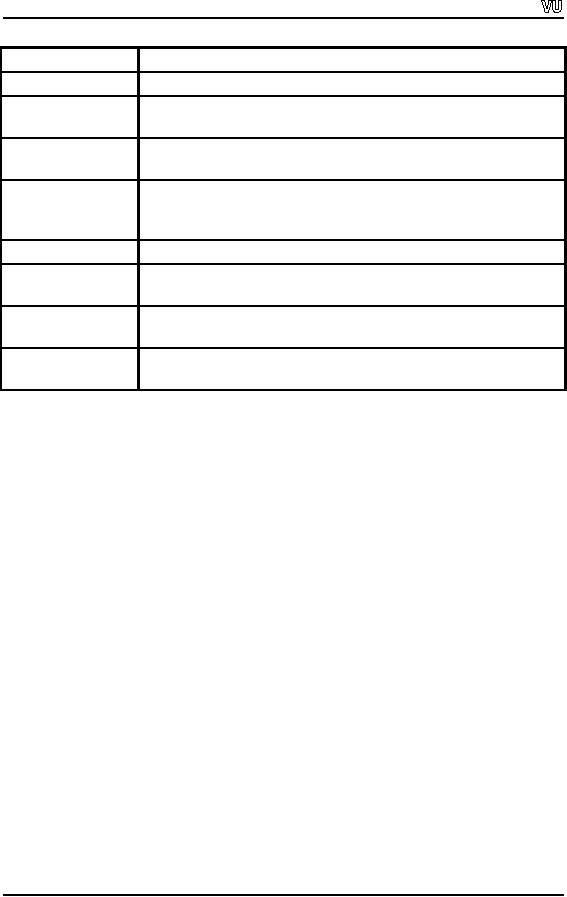
CS201
Introduction to Programming
Returns
true
if
c
is a
lowercase letter and false
otherwise.
int
islower( int c )
int
isupper( int c ) Returns
true
if
c
is an
uppercase letter; false
otherwise.
int
tolower( int c ) If c
is an
uppercase letter, tolower
returns
c
as a
lowercase letter.
Otherwise,
tolower
returns
the argument
unchanged.
int
toupper( int c ) If c
is a
lowercase letter, toupper
returns
c
as an
uppercase letter.
Otherwise,
toupper
returns
the argument
unchanged.
Returns
true
if
c
is a
white-space character--newline ('\n'),
space
int
isspace( int c )
('
'),
form feed ('\f'),
carriage return ('\r'),
horizontal tab ('\t'),
or
vertical
tab ('\v')--and
false
otherwise
Returns
true
if
c
is a
control character and false
otherwise.
int
iscntrl( int c )
Returns
true
if
c
is a
printing character other
than a space, a
digit,
int
ispunct( int c )
or a letter
and false
otherwise.
Returns
true
value if
c
is a
printing character including
space ('
')
int
isprint( int c )
and
false
otherwise.
int
isgraph( int c ) Returns
true
if
c
is a
printing character other
than space ('
')
and
false
otherwise.
The
functions tolower
and
toupper
are
conversion functions. The tolower
function
converts
its uppercase letter argument
into a lowercase letter. If its
argument is other
than
uppercase
letter, it returns the argument
unchanged. Similarly the toupper
function
converts
its lowercase letter argument
into uppercase letter. If its
argument is other
than
lowercase
letter, it returns the argument
without effecting any
change.
Sample
Program
Let's
consider the following
example to further demonstrate
the use of the functions
of
ctype.h.
Suppose, we write a program
which prompts the user to
enter a string. Then
the
string entered is checked to
count different types of
characters (digit, upper
and
lowercase
letters, white space etc).
We keep a counter for each
category of character
entered.
When the user ends
the input, the number of
characters entered in
different
types
will be displayed. In this
example we are using a
function getchar(), instead of
cin
to get
the input. This function is
defined in header file as
stdio.h. While carrying
out
character
manipulation, we use the
getchar() function. This
function reads a
single
character
from the input buffer or
keyboard. This function can
get the new line
character
`\n'
(the ENTER key) so we run
the loop for input
until user presses the
ENTER key. As
soon as
the getchar() gets the
ENTER key pressed (i.e.
new line character `\n'),
the loop
is terminated. We
know that, every C statement
returns a value. When we use
an
assignment
statement ( as used in our
program c = getchar()), the
value assigned to the
left
hand side variable is the
value of the statement too.
Thus, the statement (c
=
getchar())
returns the value that
is assigned to char c. Afterwards,
this value is
compared
with the new line
character `\n'. If it is not
equal inside the loop, we
apply the
Page
197
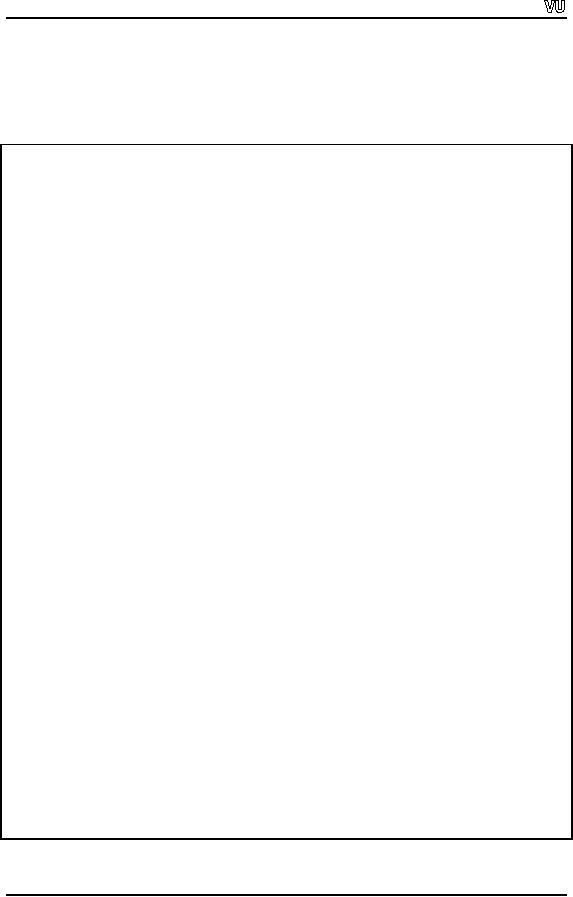
CS201
Introduction to Programming
tests on c to
check whether it is uppercase
letter, lowercase letter or a
digit etc. In this
program,
the whole string entered by
the user is manipulated
character.
Following is
the code of this
program.
//
Example: analysis of text
using <ctype.h> library
#include
<iostream.h>
#include
<stdio.h>
#include
<ctype.h>
main()
{
char
c;
int i =
0, lc = 0, uc = 0, dig = 0, ws = 0, pun = 0,
oth = 0;
cout
<< "Please enter a character string
and then press ENTER:
";
//
Analyse text as it is
input:
while ((c
= getchar()) != '\n')
{
if
(islower(c))
lc++;
else if
(isupper(c))
uc++;
else if
(isdigit(c))
dig++;
else if
(isspace(c))
ws++;
else if
(ispunct(c))
pun++;
else
oth++;
}
// display
the counts of different
types of characters
cout
<< "You typed:"<<
endl;
cout<<
"lower case letters =
"<< lc<< endl;
cout
<< "upper case letters = " <<
uc <<endl;
cout<<
"digits = " << dig <<
endl;
cout<<
"white space = "<< ws <<
endl;
cout<<
"punctuation = "<< pun<<
endl;
cout<<
"others = "<< oth;
}
Page
198
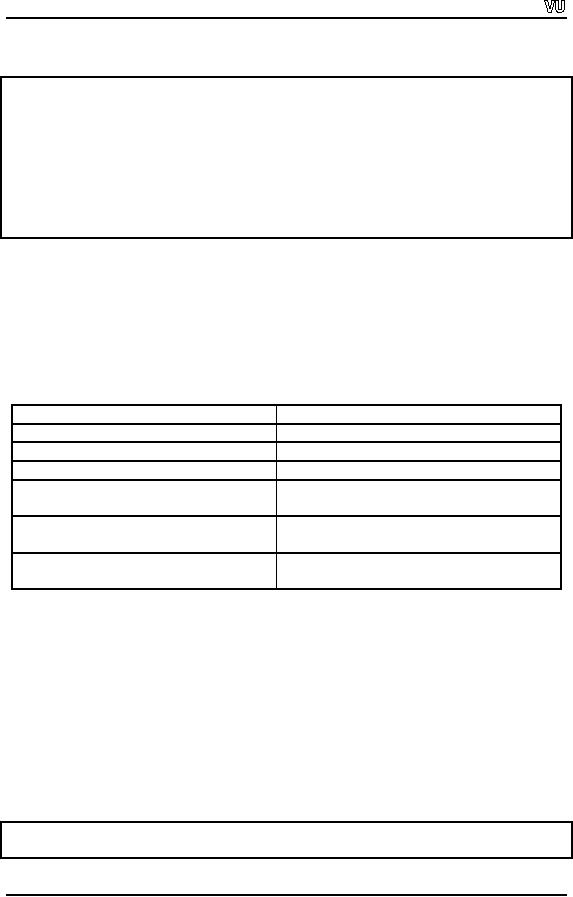
CS201
Introduction to Programming
A sample
output of the program is given
below.
Please
enter a character string and
then press ENTER: Sixty
Five = 65.00
You
typed:
lower
case letters = 7
upper
case letters = 2
digits =
4
white
space = 3
punctuation
= 2
others =
0
String
Conversion Functions
The
header file stdlib.h
includes functions,
used for different
conversions. When we get
input of
a different type other than
the type of variable in which the
value is being
stored,
it
warrants the need to convert
that type into another type.
These conversion functions
take an
argument of a type and return it
after converting into another type.
These
functions
and their description are given in the
table below.
Prototype
Description
Converts
the string nPtr
to
double.
double
atof( const char *nPtr
)
Converts
the string nPtr
to
int.
Int
atoi( const char *nPtr
)
Converts
the string nPtr
to
long int.
long
atol( const char *nPtr
)
Converts
the string nPtr
to
double.
double
strtod( const char *nPtr,
char
**endPtr
)
Converts
the string nPtr
to
long.
long
strtol( const char *nPtr,
char
**endPtr,
int base )
Converts
the string nPtr
to
unsigned
long.
unsigned
long strtoul( const
char
*nPtr,
char **endPtr, int base
)
Use
of these functions:
While
writing main () in a program, we
can put them inside the
parentheses of main.
`int
arg c,
char ** arg v are written
inside the parentheses. The
arg
c is
the count of number
of
arguments passed to the program
including the name of the
program itself while arg
v
is a vector of
strings or an array of strings. It is
used while giving command
line
arguments
to the program. The
arguments in the command line
will always be
character
strings.
The number in the command
line (for example 12.8 or
45) are stored as
strings.
While
using the numbers in the
program, we need these
conversion functions.
Following
is a simple program which demonstrate
the use of atoi
function.
This program
prompts
the user to enter an integer
between 10-100, and checks
if a valid integer is
entered.
//This
program demonstrate the use
of atoi function
Page
199
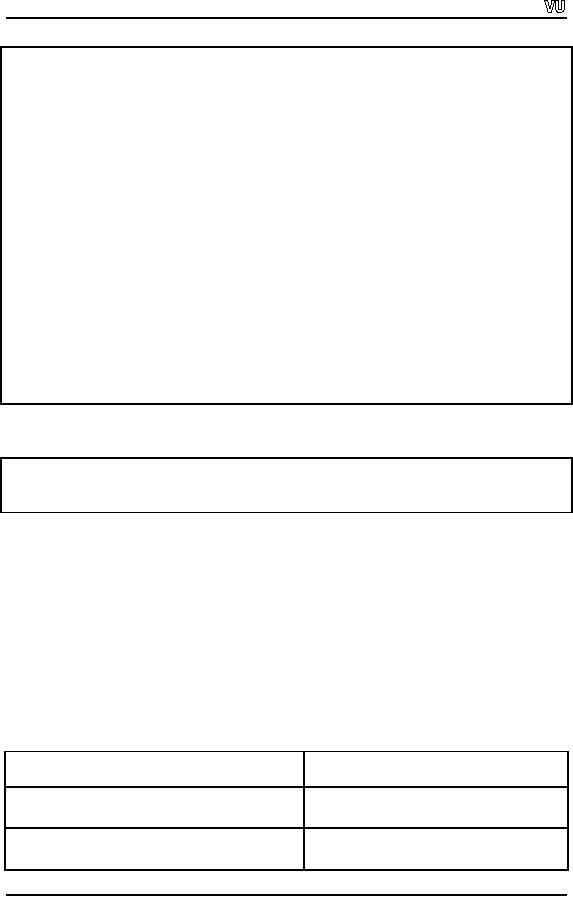
CS201
Introduction to Programming
# include
<iostream.h>
# include
<stdlib.h>
main(
)
{
int
anInteger;
char
myInt [20]
cout
<< "Enter an integer between
10-100 : ";
cin
>> myInt;
if
(atoi(myInt) == 0)
cout
<< "\nError : Not a valid
input"; // could be non
numeric
else
{
anInteger
= atoi(myInt);
if
(anInteger < 10 || anInteger >
100)
cout
<< "\nError : only integers
between 10-100 are
allowed!";
else
cout
<< "\n OK, you have
entered " << anInteger;
}
}
The
output of the program is as
follows.
Enter an
integer between 10-100 :
45.5
OK,
you have entered 45
String
Functions
We know a
program to guess a number, stored in
the computer. To find out a
name
(which is
a character array) among many
names in the memory, we can
perform string
comparison
on two strings by comparing a character
of first string with the
corresponding
character
of the second string. Before doing this, we
check the length of both the
strings
to
compare. C library provides functions to
compare strings, copy a string and
for other
string
manipulations.
The
following table shows the string
manipulation functions and their
description. All
these
functions are defined in the
header file string.h, in the
C library.
Function
prototype
Function
description
Copies
string s2
into
character array s1.
char
*strcpy( char *s1, const
char *s2 )
The
value of s1 is
returned.
Copies at
most n
characters
of string s2
char
*strncpy( char *s1, const
char *s2,
into
array s1. The
value of s1 is
size_t
n )
Page
200
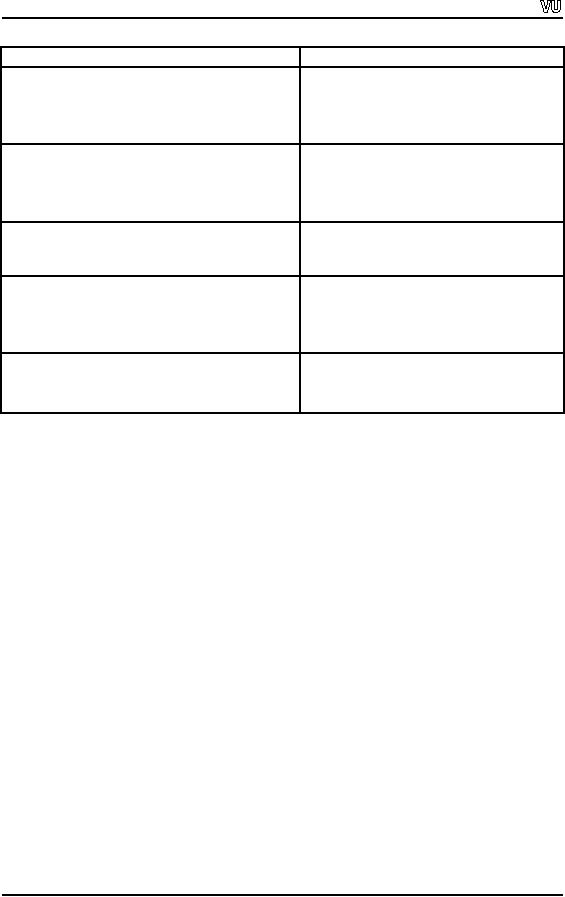
CS201
Introduction to Programming
returned.
Appends
string s2
to
array s1. The
first
char
*strcat( char *s1, const
char *s2 )
character
of s2
overwrites
the
terminating
null character of s1.
The
value of
s1
is
returned.
Appends
at most n
characters
of string
char
*strncat( char *s1, const
char *s2,
s2 to array
s1. The
first character of s2
size_t
n )
overwrites
the terminating null
character
of s1. The
value of s1 is
returned.
int
strcmp( const char *s1,
const char *s2) Compares
string s1
to
s2.
Returns
a
negative
number if s1 <
s2,
zero if s1
==
s2
or a
positive number if s1 >
s2
int
strncmp( const char *s1,
const char *s2, Compares
up to n
characters
of string s1
to s2. Returns
a negative number if s1
<
size_t
n )
s2, zero if
s1 == s2
or a
positive number
if s1 >
s2.
int
strlen ( const char
*s)
Determines
the length of string s. The
number of
characters preceding
the
terminating
null character is
returned.
Let's
look at the string copy function
which is strcpy. The
prototype of this function is
char
*strcpy( char *s1, const
char *s2 )
Here the
first argument is a pointer to a
character array or string s1 whereas
the second
argument
is a pointer to a string s2. The string s2 is
copied to string s1 and a pointer
to
that
resultant string is returned. The string
s2 remains the same. We can
describe the
string s1 as
the destination string and s2 as
the source string. As the
source remains the
same
during the execution of strcpy
and
other string functions, the const
keyword
is used
before
the name of source string.
The const
keyword
prevents any change in the
source
string (i.e.
s2). If we want to copy a number of
characters of a string instead of the
entire
string,
the function strncpy
is employed. The
function strncpy
has
arguments a pointer
to
destination strings (s1), a pointer to
source string (s2) . The
third argument is int
n.
Here n
is
the number of characters
which we want to copy from
s2
into
s1. Here s1
must
be large
enough to copy the n
number of
characters.
The
next function is strcat
(string
concatenation). This function
concatenates (joins)
two
strings.
For example, in a string, we have first
name of a student, followed by
another
string,
the last name of the
student is found. We can concatenate
these two strings to get
a
string,
which holds the first
and the last name of
the student. For this
purpose, we use the
strcat
function.
The prototype of this function is
char
*strcat( char *s1, const
char *s2
). This
function writes the string s2
(source) at the end of the
string s1(destination). The
characters
of s1 are not overwritten. We
can concatenate a number of
characters of s2 to
s1 by
using the function strncat. Here we provide
the function three
arguments, a
character
pointer to s1, a character pointer to s2
while third argument is the
number of
characters
to be concatenated. The prototype of this
function is written as
char
*strncat( char *s1, const
char *s2, size_t n )
Page
201
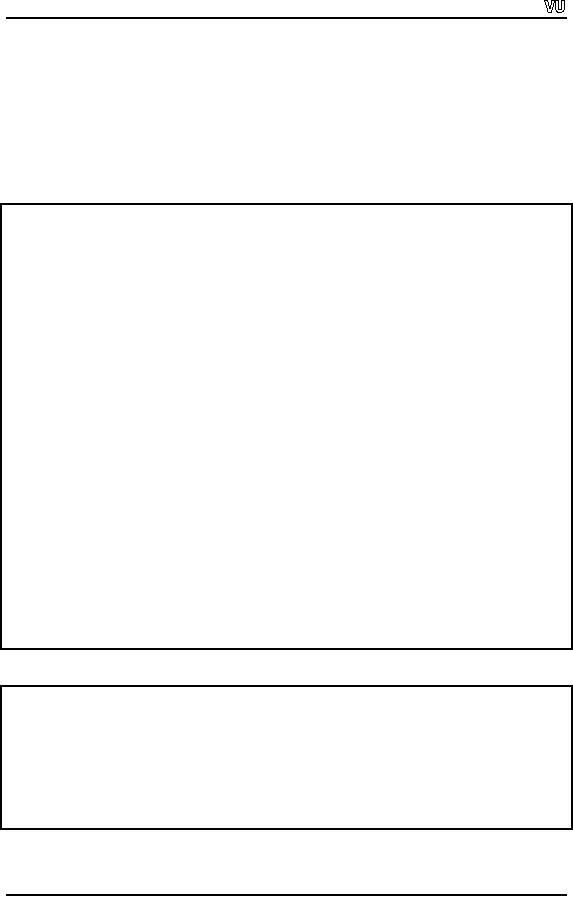
CS201
Introduction to Programming
Examples
Let's
consider some simple examples to
demonstrate the use of strcpy,
strncpy, strcat
and
strncat functions. To
begin with, we can fully
understand the use of the
function
strcpy
and
strncpy.
Example
1
//Program to display
the operation of the strcpy()
and strncpy()
#
include<iostream.h>
#
include<string.h>
void
main()
{
char
string1[15]="String1";
char
string2[15]="String2";
cout<<"Before
the copy :"<<endl;
cout<<"String
1:\t"<<string1<<endl;
cout<<"String
2:\t"<<string2<<endl;
//copy
the whole string
strcpy(string2,string1);
//copy string1 into string2
cout<<"After
the copy :"<<endl;
cout<<"String
1:\t"<<string1<<endl;
cout<<"String
2:\t"<<string2<<endl;
//copy
three characters of the string1
into string3
strncpy(string3,
string1, 3);
cout
<< "strncpy (string3, string1, 3) = " << string3
;
}
Following
is the output of the
program.
Before
the copy :
String
1:
String1
String
2:
String2
After
the copy :
String
1:
String1
String
2:
String1
Strncpy (string3,
string1, 3) = Str
Example
2 (strcat and strncat)
Page
202
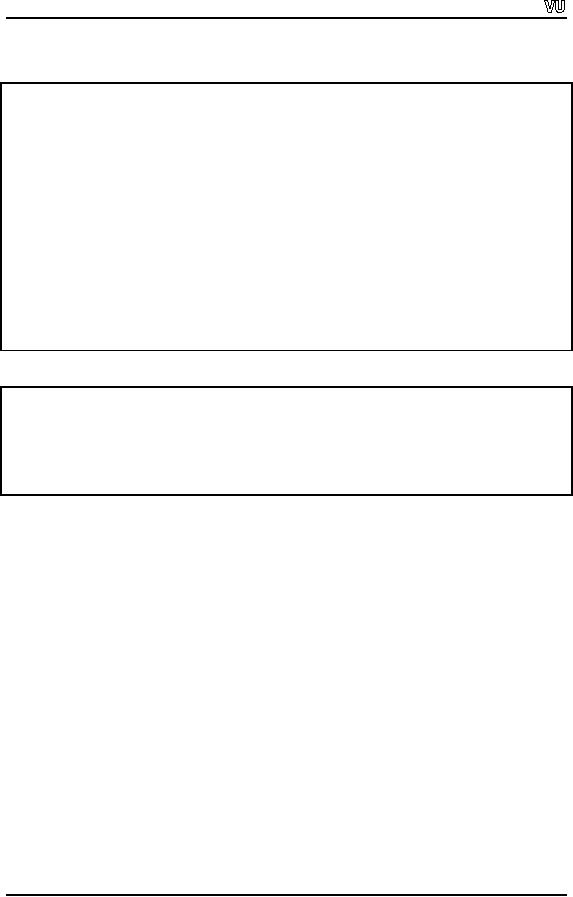
CS201
Introduction to Programming
The
following example demonstrates the
use of function strcat
and
strncat.
//Program to display
the operation of the
strcat() and
strncat()
#include
<iostream.h>
#include
<string.h>
int
main()
{
char s1[
20 ] = "Welcome to ";
char
s2[] = "Virtual University
";
char s3[
40 ] = "";
cout<<
"s1 = " << s1 << endl << "s2 = " << s2
<< endl << "s3 = " << s3 <<
endl;
cout<<
"strcat( s1, s2 ) = "<< strcat(
s1, s2 );
cout
<< "strncat( s3, s1, 6 ) = " <<
strncat( s3, s1, 6 );
}
The
output of the program is given
below.
s1 =
Welcome to
s2 =
s3
=
strcat(
s1, s2 ) = Welcome to Virtual
University
strncat(
s3, s1, 7 ) = Welcome
Now we
come across the function
strcmp.
This
function compares two
strings, and
returns
an integer value depending upon
the result of the
comparison. The prototype of
this
function is
int
strcmp( const char *s1,
const char *s2)
This
function returns a number
less than zero (a negative
number), if s1 is less than
s2. It
returns
zero if s1 and s2 are
identical and returns a
positive number (greater
than zero) if
s1 is
greater than s2. The
space character in a string and
lower and upper case
letters are
also
considered while comparing two
strings. So the strings
"Hello", "hello" and "He
llo"
are
three different strings
these are not
identical.
Similarly
there is a function strncmp, which
can be used to compare a
number of
characters
of two strings. The prototype of
this function is
int
strncmp( const char *s1,
const char *s2, size_t n
)
Here s1
and s2 are two strings
and n
is
the number upto which
the characters of s1 and
s2
are
compared. Its return type is
also int. It
returns a negative number if
first n characters
of s1 are
less than first n characters
of s2. It returns zero if n
characters of s1 and n
characters
of s2 are identical. However, it
returns a positive number if n
characters of s1
are
greater than n characters of
s2.
Now we
will talk about the
function, `strlen'
(string length)
which is used to
determine
the
length of a character string. This
function returns the length of
the string passed to
it.
The
prototype of this function is given
below.
int
strlen ( const char
*s)
Page
203
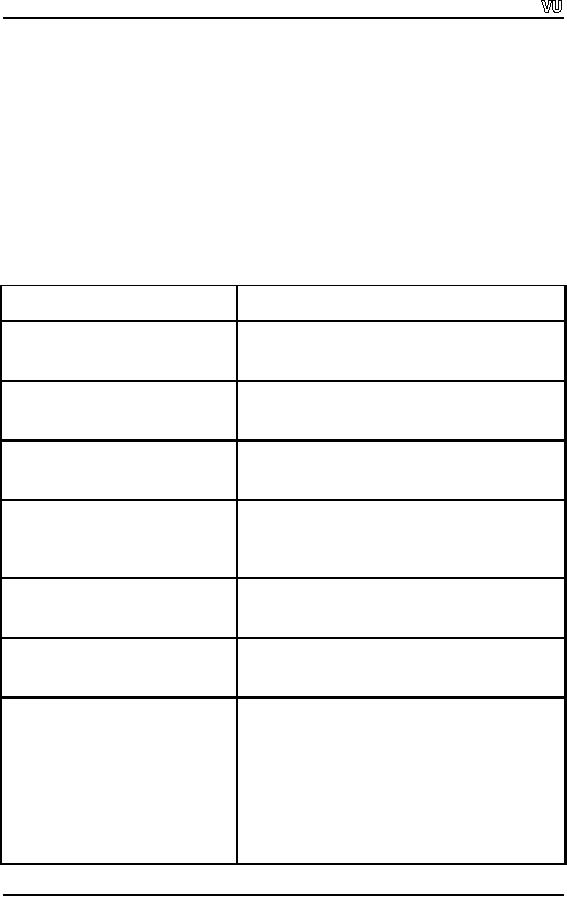
CS201
Introduction to Programming
This
function determines the length of string
s. the number of characters
preceding the
terminating
null character is
returned.
Search
Functions
C
provides another set of functions
relating to strings, called search functions.
With the
help of
these functions, we can do different
types of search in a string. For example,
we
can
find at what position a
specific character exists. We can
search a character starting
from
any position in the string. We
can find the preceding or
proceeding string from a
specific
position. We can find a string inside
another string. These functions are given
in
the
following table.
Function
prototype
Function
description
Locates
the first occurrence of
character c
in
string
char
*strchr( const char *s, int
c
s. If c
is
found, a pointer to c
in
s
is
returned.
);
Otherwise, a
NULL
pointer is
returned.
Determines
and returns the length of
the initial
size_t
strcspn( const char
*s1,
segment
of string s1
consisting of
characters not
const
char *s2 );
contained
in string s2.
Determines
and returns the length of
the initial
size_t
strspn( const char
*s1,
segment
of string s1
consisting
only of characters
const
char *s2 );
contained
in string s2.
Locates
the first occurrence in string
s1
of
any
char
*strpbrk( const char
*s1,
character
in string s2. If a
character from string s2
const
char *s2 );
is found, a pointer to
the character in string s1
is
returned.
Otherwise, a NULL
pointer is
returned.
char
*strrchr( const char *s, int
c Locates
the last occurrence of c
in
string s. If c
is
found, a pointer to
c
in
string s
is
returned.
);
Otherwise, a
NULL
pointer is
returned.
char
*strstr( const char *s1,
const Locates
the first occurrence in string
s1
of
string s2.
If the
string is found, a pointer to the string in s1
is
char
*s2 );
returned.
Otherwise, a NULL
pointer is
returned.
char
*strtok( char *s1, const
char A
sequence of calls to strtok
breaks
string s1
into
"tokens"--logical
pieces such as words in a
line of
*s2
);
text--separated by
characters contained in string
s2. The
first call contains s1
as
the first argument,
and
subsequent calls to continue tokenizing
the
same
string contain NULL
as
the first argument. A
pointer to
the current token is
returned by each
call.
If there
are no more tokens when
the function is
called,
NULL
is
returned.
Page
204
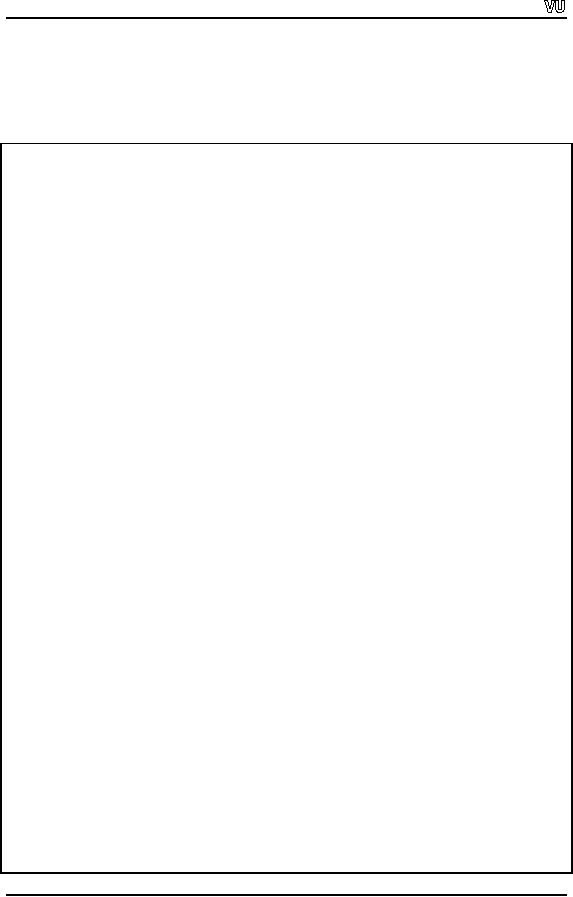
CS201
Introduction to Programming
Example
3
Here is an example,
which shows the use of
different string manipulation
functions.
The
code of the program is given
below.
//A
program which shows string
manipulation using <string.h>
library
#include
<iostream.h>
#include
<string.h>
#include
<stdlib.h>
main()
{
char
s1[] = "Welcome to " ;
char
s2[] = "Virtual University"
;
char
s3[] = "Welcome to Karachi"
;
char
city[] = "Karachi";
char
province[] = "Sind";
char
s[80];
char
*pc;
int
n;
cout
<< "s1 = " << s1 << endl << "s2 = "
<< s2 << endl ;
cout
<< "s3 = " << s3 << endl ;
//
function for string length
cout
<< "The length of s1 = " << strlen(s1)
<< endl ;
cout
<< "The length of s2 = " << strlen(s2)
<< endl ;
cout
<< "The length of s3 = " << strlen(s3)
<< endl ;
strcpy(s,
"Hyderabad"); // string copy
cout<<
"The nearest city to "<<
city << " is " << s << endl
;
strcat(s,
" and "); // string
concatenation
strcat(s,city);
strcat(s,
" are in ");
strcat(s,
province);
strcat(s,
".\n");
cout
<< s;
if (!(strcmp
(s1,s2))) // ! is used as zero is
returned if s1 & s2 are
equal
cout
<< "s1 and s2 are identical"
<< endl ;
else
cout
<< "s1 and s2 are not
identical" << endl ;
if (!(strncmp
(s1,s3,7)))
// ! is
used as zero is returned for
equality
cout
<< "First 7 characters of s1 and s3
are identical" << endl
;
Page
205
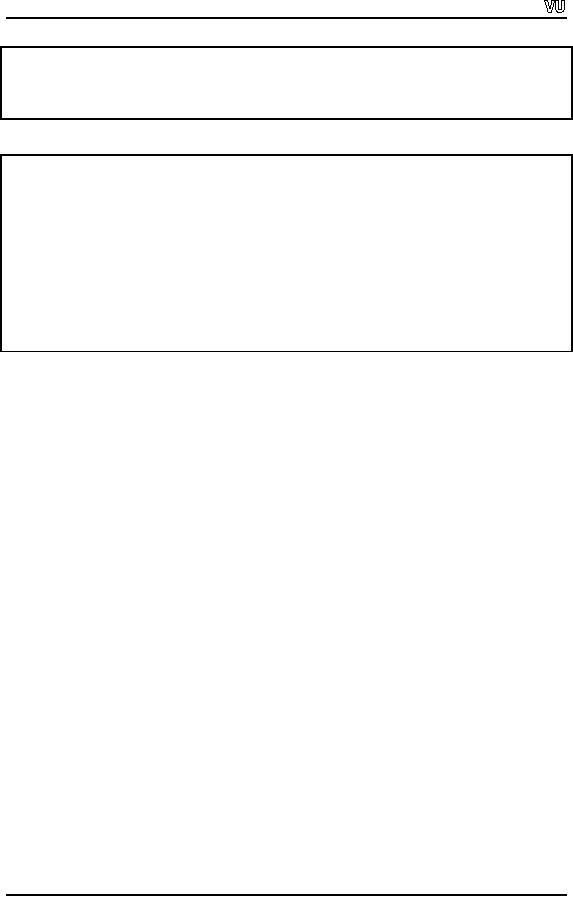
CS201
Introduction to Programming
else
cout
<< "First 7 characters of s1 and s3
are not identical" <<
endl ;
}
Following
is the output of the
program.
S1 =
Welcome to
S2 =
S3 =
Welcome to Karachi
The
length of s1 = 11
The
length of s2 = 18
The
length of s3 = 18
The
nearest city to Karachi is
Hyderabad
Hyderabad
and Karachi are in
Sind.
S1 and s2
are not identical
First 7
characters of s1 and s3 are
identical
Exercises
1: Write
a program that displays the
ASCII code set in tabular
form on the screen.
2: Write
your own functions for
different manipulations of
strings.
3: Write
a program, which uses
different search functions.
Page
206
Table of Contents:
- What is programming
- System Software, Application Software, C language
- C language: Variables, Data Types, Arithmetic Operators, Precedence of Operators
- C++: Examples of Expressions, Use of Operators
- Flow Charting, if/else structure, Logical Operators
- Repetition Structure (Loop), Overflow Condition, Infinite Loop, Properties of While loop, Flow Chart
- Do-While Statement, for Statement, Increment/decrement Operators
- Switch Statement, Break Statement, Continue Statement, Rules for structured Programming/Flow Charting
- Functions in C: Structure of a Function, Declaration and Definition of a Function
- Header Files, Scope of Identifiers, Functions, Call by Value, Call by Reference
- Arrays: Initialization of Arrays, Copying Arrays, Linear Search
- Character Arrays: Arrays Comparisonm, Sorting Arrays Searching arrays, Functions arrays, Multidimensional Arrays
- Array Manipulation, Real World Problem and Design Recipe
- Pointers: Declaration of Pointers, Bubble Sort Example, Pointers and Call By Reference
- Introduction, Relationship between Pointers and Arrays, Pointer Expressions and Arithmetic, Pointers Comparison, Pointer, String and Arrays
- Multi-dimensional Arrays, Pointers to Pointers, Command-line Arguments
- String Handling, String Manipulation Functions, Character Handling Functions, String Conversion Functions
- Files: Text File Handling, Output File Handling
- Sequential Access Files, Random Access Files, Setting the Position in a File, seekg() and tellg() Functions
- Structures, Declaration of a Structure, Initializing Structures, Functions and structures, Arrays of structures, sizeof operator
- Bit Manipulation Operators, AND Operator, OR Operator, Exclusive OR Operator, NOT Operator Bit Flags Masking Unsigned Integers
- Bitwise Manipulation and Assignment Operator, Programming Constructs
- Pre-processor, include directive, define directive, Other Preprocessor Directives, Macros
- Dynamic Memory Allocation, calloc, malloc, realloc Function, Dangling Pointers
- History of C/C++, Structured Programming, Default Function Arguments
- Classes and Objects, Structure of a class, Constructor
- Classes And Objects, Types of Constructors, Utility Functions, Destructors
- Memory Allocation in C++, Operator and Classes, Structures, Function in C++,
- Declaration of Friend Functions, Friend Classes
- Difference Between References and Pointers, Dangling References
- Operator Overloading, Non-member Operator Functions
- Overloading Minus Operator, Operators with Date Class, Unary Operators
- Assignment Operator, Self Assignmentm, Pointer, Conversions
- Dynamic Arrays of Objects, Overloading new and delete Operators
- Source and Destination of streams, Formatted Input and Output, Buffered Input/Output
- Stream Manipulations, Manipulators, Non Parameterized Manipulators, Formatting Manipulation
- Overloading Insertion and Extraction Operators
- User Defined Manipulator, Static keyword, Static Objects
- Pointers, References, Call by Value, Call by Reference, Dynamic Memory Allocation
- Advantages of Objects as Class Members, Structures as Class Members
- Overloading Template Functions, Template Functions and Objects
- Class Templates and Nontype Parameters, Templates and Static Members
- Matrices, Design Recipe, Problem Analysis, Design Issues and Class Interface
- Matrix Constructor, Matrix Class, Utility Functions of Matrix, Input, Transpose Function
- Operator Functions: Assignment, Addition, Plus-equal, Overloaded Plus, Minus, Multiplication, Insertion and Extraction